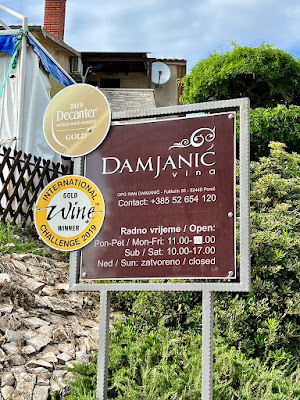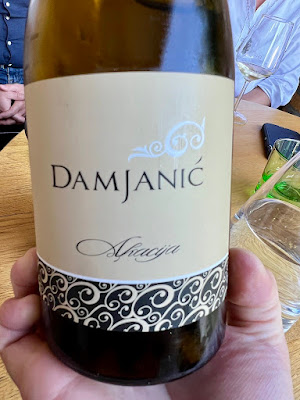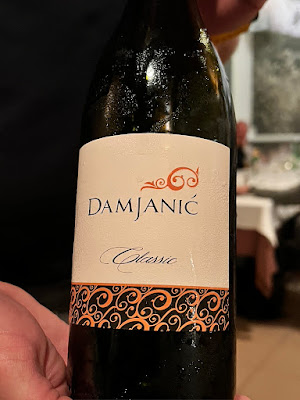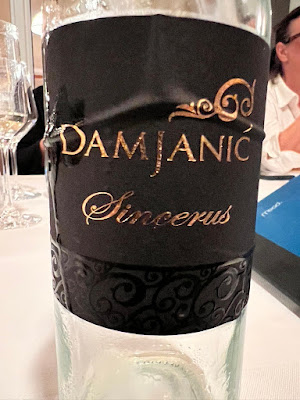During our time in Istria, on our two-week tour of Croatia, we stopped at the Damjanić Vina for a wine tasting, and later accompanied the wine-maker and others to a nearby seafood restaurant for a superb dinner paired with Damjanić wines. It's a winery with a rich history, as well as a more recent phoenix-like resurrection. A tale of passion and determination, an embracing of tradition as well as a willingness to experiment.
The Jurković family history of winemaking extends back to the early 18th century, when they first planted vineyards in the Fuškulin area near Poreč. They eventually became one of the leading wineries in the area.
We met Ivan Damjanić, the current owner and winemaker, and he regaled us with the tale of Giorgio Jurković, his great grandfather, on his mother's side. In 1928, Giorgio entered a red wine at the Exposition Du Bien-Etre in Paris, and he won a Diploma of Grand Prix and a Gold Medal for an Istrian wine (pictured above). This is the oldest award for any Croatian wine, so it's quite an achievement. The wine he entered was a red blend of Teran and Borgonja (an Istrian term for Blaufränkisch). Unfortunately, Giorgio had to pay for the diploma to be sent to him, and the cost was 40 Lira, equivalent to the value of a cow. So, Giorgio had to sell one of his cows so he could receive his award.
Unfortunately, around 1947, when Yugoslavia took control of the region, they nationalized much of the land, and the Jurković lost nearly all of their vineyards. This could have been the end of the family's winery forever. However, Ivan's grandfather maintained a very small vineyard, which likely produced only enough wine for the family. When Ivan was young, he helped out his grandfather in the vineyard, sparking a passion within him which would eventually lead Ivan to study agronomy and enology, making his grandfather very happy.
When Ivan was 24 years old, he told his parents he wanted to start a winery, although he had little financial resources at the time. To raise money, he first sold his car and motorcycle, and tried to obtain a loan but was denied. Finally, his parents offered to help him, and took out a mortgage to provide him the funds to buy vines and a tractor. In 1999, he started his winery, Damjanić Vina, beginning with only a tiny portion of land. This was the first big step toward the resurrection of the family winery.
Today, Ivan owns about 10.5 hectares of vineyards and a modernly cellar, although he's planning on building a new winery. During these years, Ivan also got married in 2014 (which was a terrible wine vintage), to Željka, who he met in 2011. Damjanić produces 11 different labels, many made using native grapes, such as Malvazija Istarska and Borgonja, and their annual production is about 70K-90K bottles.
In Istria, the Borgonja grape, also known in other regions as Blaufränkisch and as Frankovka in the Slavonia region of Croatia, isn't widely planted. There's a saying that there is "no mercy with Borgonja," that it's a difficult grape to grow. However, Ivan is known as the "Emperor of Borgonja," embracing a love for this grape that comes from his grandfather. It's also Željka's favorite grape, as well as the most planted red grape at the winery.
In the vineyard, Ivan's Borgonja comes from vines that were planted by his great-grandfather back in 1915, and they are low yielding vines. It was stated that Borgonja produces wines with medium body, good balance, and lots of fruitiness, although it doesn't create full-bodied wines. In some respects, it was noted the wines can compare to Pinot Noir. As the Teran grape can be wild and tough to control, Borgonja can be added to it to tame that wildness. And it was that specific blend which won the cherished awards in 1928.
We began our tasting with the Damjanić Virtu Brut, a sparkling wine, with a 12% ABV, made in the Charmat method, from a blend of 60% Malvazija Istarska, 30% Chardonnay, and 10% Pinot Blanc. It was pleasant and refreshing, with nice flavors of melon and citrus, light floral notes, and plenty of tiny bubbles.
The 2021 Damjanić Malvasia Istarska, with a 13% ABV, was aged in stainless steel on the lees. It had an alluring aroma, and on the palate, it was fresh, crisp, bright and fruity, with tasty, juicy flavors of apple and pear, with a touch of floral notes. A nice complexity to this wine, with additional hints of herbs and salinity. This would be an excellent summer wine, or paired with seafood or other lighter dishes. Highly recommended.
The 2019 Damjanić Malvazija Akacija, with a 13.5% ABV, was aged for 8-12 months in 225 liter Acacia barrels. Acacia barrels have been used in Croatia for at least 500 years, and it's more gentle than oak. For this wine, the barrels were constructed from French and Italian acacia, and they cost 25%-30% more than oak barrels. They also char the acacia barrels less than they would oak. This wine had a more unique taste, possessing some of the usual Malvazija elements, but with the addition of more spice notes and a touch of smoke. Complex, excellent fruit, and a lengthy, satisfying finish. It was said that this wine can age well for at least 10-12 years. Highly recommended.
The 2019 Damjanić Clemente Blanc, with a 13.5% ABV, was a blend of 60% Malvazija Istarska, 30% Chardonnay, and 10% Pinot Blanc. It was aged in French oak for about a year. The blend is consistent year to year, although 2015 was the first vintage with the addition of the Pinot Blanc. It was said that this "wine isn't easy to describe" as it changes constantly in the glass. A compelling nose, with lots on the palate, including notes of peach, pear and tropical fruits, mild spices and a touch of floral notes. Elegant, intriguing and complex, with a long and lingering finish. A versatile wine with various food pairings. Also highly recommended.
The 2021 Damjanić Rosé Penelope (the name has no real connection to anyone), with a 13% ABV, was made from 100% Borgonja. Fresh, crisp, dry and fruity, this was a very pleasant wine, great for summer as well as a very good food wine.
The 2020 Damjanić Borgonja, with a 13% ABV, was made from 100% Borgonja, and aged in oak for 2-3 months. With a fruity nose, the wine was delicious with good acidity, flavors of raspberry and plum, as well as touches of black pepper and violets. Mild tannins, a pleasing finish, and an easy drinking nature. A very good, everyday pizza and burger wine.
The 2018 Damjanić Duro Istriano, with a 13% ABV, was a blend of 50% Teran, 50% Borgonja, the same blend as his great-grandfather's 1928 award winning wine. Ivan noted "this is the real Istrian." It was aged for about a year in French and Slavonian oak. This was a more powerful wine, with stronger tannins, yet it wasn't overpowering. The taste was complex, well balanced and intriguing, with notes of ripe plum and black cherry, a strong spicy element as well as numerous herbal notes. A lengthy and pleasing finish, I was also pleased that it was only 13% ABV. This is a wine that calls out for steak or a hearty dish. Highly recommended.
The 2016 Damjanić Clemente Red, with a 14% ABV, was a blend of 60% Merlot, 20% Cabernet Sauvignon, 10% Teran, and 10% Borgonja. It was an international style wine with a touch of Istria. It was a softer red wine, with restrained tannins, black fruit flavors and spicy backbone.
Ivan's passion for wine pays homage to his ancestors who first planted vineyards in this region. And I'm sure they would be proud of what Ivan has accomplished, as he produces excellent wines, representing well the Istrian region. Ivan was also personable and down-to-earth, making him a fine ambassador for his winery as well.
After the tasting, we drove south for about 9 kilometers to the small town of Vrsar, located on the Istrian coast.
In the marina, we dined at Restoran Trošt, a family owned seafood restaurant which has been around since 1988. One side of the restaurants looks out into the ocean, and we were seated in that section. Ivan had chosen a number of his wines to accompany our dinner, which was a seafood lover's paradise.
Our first course consisted of a few plates of raw seafood, including Shrimp and Sea Bass. Silky and tender, with a nice, clean taste.
There were Oysters from the waters near Premantura, a small village at the southernmost tip of Istria. Meaty, briny and very tasty.
The Clams were also very good as well, although my preference was the oysters.
The Fish Soup had an excellent and delicious broth, with plenty of pieces of tender white fish.
Maybe my favorite dish of the night with was Shrimp Risotto, a well-made risotto with a creamy texture, great flavors and nice pieces of shrimp. I had a couple portions of this dish as it was just so delicious. I had a few Risottos in Istria, and enjoyed all of them, showing the Italian influence in this region.
We next enjoyed a Grilled Branzino, and the whole fish was sliced up table side.
The Branzino was also delicious, sweet and tender fish, with that touch of char on the skin.
The fish head was served to us as well, and one of my dining companions ate it, obviously enjoying it very much.
Dessert was Palačinke, Croatian crepes, with ice cream and nuts. A tasty ending to our seafood paradise.
The final wine of the evening was the 2015 Damjanić Sincerus, made from 100% Malvazija Istarska, It was aged in oak for about a year and only 500-600 bottles were produced. This dessert wine was sweet, but balanced with good acidity. Notes of honey, candied fruit, citrus, and subtle spices. A fine way to end our dinner and tasting.





























No comments:
Post a Comment